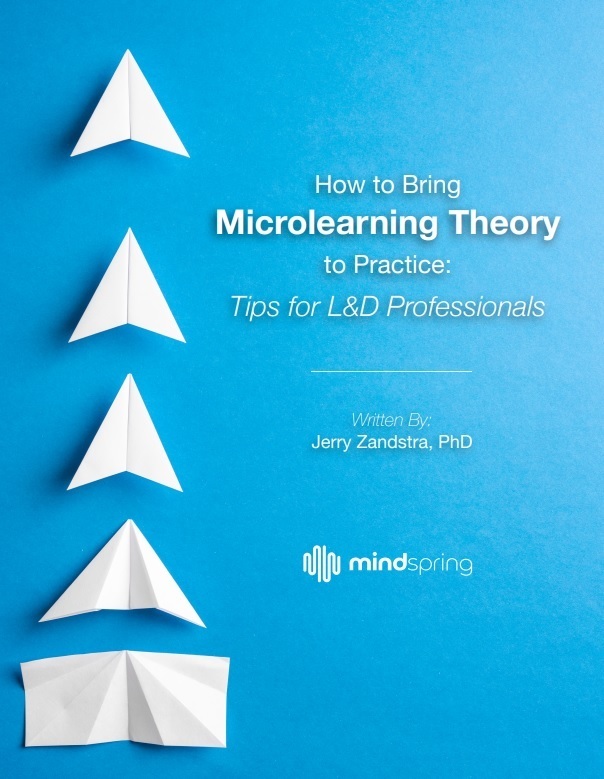Boost Your Training With This Microlearning How-To Guide
In the spirit of microlearning, we offer these tips, tricks, and techniques in short, digestible pieces. This list of microlearning’s qualities is more of a reference guide than a systematic overview of the topic. Several items in this list are true of all well-designed learning assets but are especially true for microlearning. Others are specific to the microlearning methodology. All aim to encourage learners to develop an appetite for learning.

1. Engaging
Engagement can come from many techniques, including gamification, graphics, scenarios, animation, video, and story design. Part of knowing what will engage a specific group of learners is getting to know them. Find out how they like to learn. Ask their preferences. Not everyone finds the same thing engaging. It’s worth the time to ask. Learning that isn’t challenging enough disengages participants. Learning that’s too difficult tends to be overwhelming. Both scenarios create the likelihood that learners won’t stay engaged.
2. Accessible Microlearning
Microlearning that’s challenging to find defeats the purpose. If people have to leave their workstations to find it or spend twenty minutes searching for the three minutes of information they need, they’re much less likely to take advantage of the learning opportunities created for them. Expectations for accessibility are high, especially among younger learners. Bring the learning as close to the learner as is possible.
3. Relevant
Relevance certainly is related to content. Learning directed at a situation the learner hasn’t yet experienced isn’t likely to stick as well as learning that scratches an immediate itch. There can also be relevance built into the delivery methodology.
4. Visual
A general rule of thumb for visualization is to try to use as few words as possible without losing clarity or the core of the message. People can read the words. They can hear any voice-over included in the module. Providing the learner the ability to visualize the process, individual parts, or the required information is a powerful learning aid. This is why animations, videos, images, or photos are so often used in microlearning.
5. Interactive
Moving beyond seeing and hearing—for as good as they are—interactivity is powerful. Even a simple manipulation of objects or putting steps in a process in the right order better engages learners. Interactive pdfs and infographics are relatively easy to create and well worth the time.
6. Connected
Microlearning, by definition, is made up of short bits of learning that often focus on a single theme. Ideally, they serve a single objective. But that doesn’t mean they can’t be quickly located within content connected to a broader theme. Think of a sales process and a scenario where someone forgets how to log a phone call. Microlearning can quickly and easily refresh the salesperson’s memory. But it can also provide a reminder of where logging a call fits into the sales system and make clear what the next steps should be. This could be done without spoken words by locating this step on a visual continuum.
7. Deep Dive
Microlearning should engage all learners and meet the objective of the individual asset created. Some learners will find this to be enough—they learned what they needed to learn at the moment they needed the information. Certainly not all, but some learners may be interested in a deep dive into the microlearning module’s topic. A learner may need a quick refresher on how to lubricate a part, but the learner should also have the opportunity to learn more about how that part fits into the entire machine or even assembly line. More-knowledgeable and engaged learners can only benefit their organizations. Give them opportunities to deepen their understanding.
8. Branded
Every digital learning asset is an opportunity for an organization to promote and reinforce its brand internally. Organizations can keep brand colors, logos, mission statements, and taglines in front of team members with each learning opportunity in which they engage.
9. Varied Microlearning
The first microlearning animation might be engaging. It might tell a story that resonates with learners on a personal level. It achieves the learning objective and gives the learners what they need. The tenth animation might suffer from the law of diminishing returns. For the sake of engagement and learner interest, it’s a good idea to provide a wide variety of ways of communicating the learning. An animation one time. An interactive infographic the next. Well-developed learning platforms may even give the learner some choices on the way learning is delivered. Same message. Different tools.
10. Shareable Microlearning
If possible in your current LMS, make it so learners can share microlearning assets with one another. Imagine team members noticing that they’re struggling with the same process. One team member quickly finds a microlearning asset that clarifies the process and helps remove the struggle. Rather than wait for the other team members to locate the asset, how good would it be if the learner who found the answer could share that answer with fellow team members?
11. Feedback-Rich
Give learners opportunities to provide feedback early in the development process of building learning assets and throughout the life cycle of those same assets. Learners will immediately know if something is outdated or incorrect. They may have suggestions for additional topics that would be helpful. Engage them in the process and then seek feedback through every means available. People naturally engage when they’re asked for input.
12. Social
Is it possible to enable learners to share reactions with one another? Imagine the power of two people taking the same microlearning content who, despite being in different cities or even in different countries have the opportunity to share thoughts and insights with each another?
13. Simple
It takes a lot of work to make something simple. More often than not, those who build learning assets err on the side of too many objectives in microlearning than not enough. Simplicity doesn’t just happen, but it’s worth the effort, and learners will appreciate your efforts.
14. Situational Microlearning
Make the learning as specific as possible to an exact (or nearly exact) situation learners face. The more connections they can make between their tasks and the learning available to them, the better the learning will stick.
This list isn’t exhaustive. For those tasked with the vital work of moving people and organizations forward through learning, we hope it is helpful. If you want to discover more about microlearning, download the eBook How To Bring Microlearning Theory To Practice: Tips For L&D Professionals. Get to discover all the enticing microlearning tips for L&D professionals. Also, join the webinar to discover how microlearning impacted employees' behavior and transformed organizational culture.









